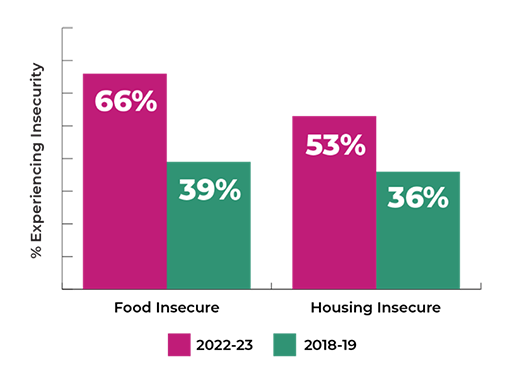过半大学生对居住不安心,66%有断炊之虞
世界日报 |2023-11-30
加州学生援助委员会(California Student Aid Commission)近日发表最新调查,2万3687名在2023年5月受访的大专学生中,53%有居住困难,66%有断炊之虞。
加州经济弱势的学生,面临的现实挑战越来越多。(取自FOXLA电视台画面)
2022-2023学年的两项比例都高于2018-19学年的调查,当时住不安心的为36%,食不安心的为39%,显示学生处境在新冠疫情后越来越糟。
报告指出,学生来自加州州大(CSU)、加州社区大学(CCC),与私立营利或非营利学校,所有学生的不安全感都高于全体总平均。
另外,就算学生获得学校的餐饮补助(meal plan),但还是有62%的人难以放心,因为餐饮计画的分量不足一周所需,而且纳入学校的餐饮补助,可能导致他们失去Cal-Fresh等补助的资格。
委员会的执行长Marine L. Garcia强调,问题相当严重,而且受到威胁的又以女性、低收、非裔、拉美裔为主,另外还有边持家边念书的在职学生。她说,调查结果显示,要完成高等教育的目标越来越难,特别是原本经济条件就不好的。
不过,值得欣慰的是,虽然经济困难,多数学生还是愿意坚持下去,因为他们相信大学是值得「投资」的资产。
California Student Aid Commission
Food and Housing Survey understanding students' basic needs
https://www.csac.ca.gov/food-and-housing-survey
In May 2023, the California Student Aid Commission (Commission) administered our inaugural Food and Housing Survey, as a supplement to the triannual Student Expenses and Resources Survey (SEARS). This survey asked students about their experiences paying for food and housing during the 2022-23 academic year.
The Commission conducts periodic surveys of California students to help inform education leaders, policymakers, and the public about the challenges and issues that students encounter. While segments of higher education survey their respective students, the Commission is uniquely positioned to survey students across all segments of higher education to provide a holistic understanding of how California college students are meeting – or not meeting – their basic needs. In 2019, the Commission released data from our Student Expenses and Resources Survey that 36% of students applying for financial aid were housing insecure and 39% were food insecure. Along with the stories from students themselves, this startling data has helped inform discussions on how California can better meet the needs of students and address their growing costs outside tuition.
Given the breadth of these challenges faced by students, the Commission administered a focused Food and Housing Survey in May 2023. The results of this year’s survey demonstrate that the basic needs challenges that our students face are persistent and intensifying across all segments of higher education. In this survey, we found that two-thirds (66%) of students were identified as food insecure while over half (53%) were housing insecure. These and other findings tell a story of higher education dreams becoming even harder to realize, especially for students who face disproportionate barriers to reaching those dreams.
To read the full report, click here: Food and Housing Survey: Understanding Students’ Basic Needs
The Food and Housing Survey and the 2018-19 SEARS both used
question modules from the USDA and US Census to determine basic
needs insecurity. The time scale for the food and housing questions
in these basic needs survey was 12 months instead of 30 days.
A fact sheet on the 2023 Food and Housing survey, along with the data codebook and survey instrument are available here:
- 2023 Food and Housing Survey Fact Sheet
- 2023 Food and Housing SURVEY DATA CODEBOOK
- 2023 Food and Housing SURVEY INSTRUMENT
Introduction With the cost of living rising faster than ever before, the conversation about the cost of attending college must include students' basic needs. Results from the 2023 Food and Housing Survey show that both food and housing insecurity have intensified for California's college students, as covering those costs has become increasingly challenging.
Previously, in the 2018-19 Student Expenses and Resources Survey (SEARS), the Commission found that, of students who applied for financial aid, 36% were housing insecure and 39% had either low or very low food security. Since that time, economic inflation and the COVID-19 pandemic have made it more difficult for students to meet their food and housing needs.
The survey provided a clear picture that those students most likely to be food and housing insecure were:
• 24 years or older
• African American or Latino/Hispanic
• Parents or primary caretakers of a child
• Attending a California community college or private for-profit institution
• Eligible for Zero Expected Family Contribution (EFC)
• Female Yet, despite the obstacle of costs, most students remained steadfast in their belief that college is a worthwhile investment.
These students’ journeys, and the data reflecting them, reinforce the state’s focus on critical reforms in financial aid and basic needs to touch more students’ lives and make it easier for them to access aid.
This report aims to inform stakeholders and decision-makers about the landscape of food and housing security and college affordability at California’s world-class institutions of higher education. Understanding the challenges students face can better inform policymakers when it comes to developing financial aid policy with students and the challenges they face at the forefront.
